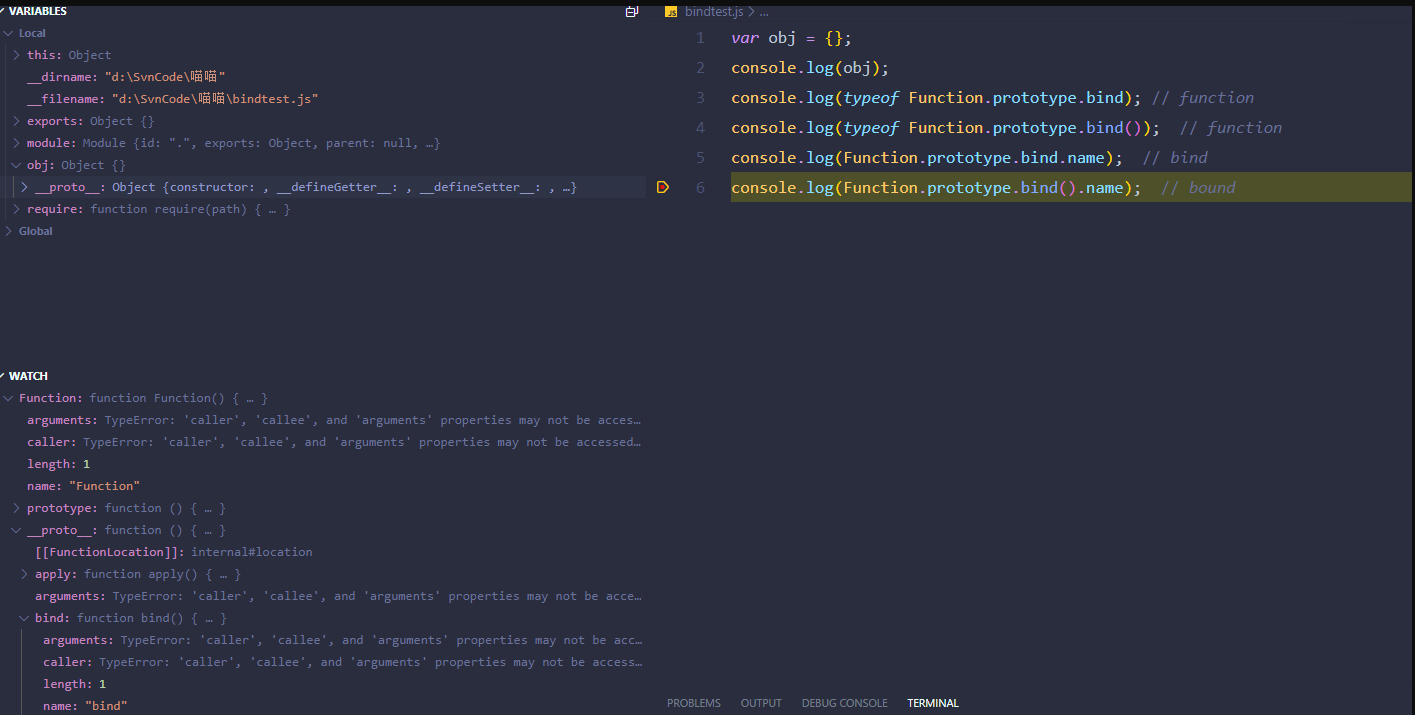目录
var obj = {};
console.log(obj);
console.log(typeof Function.prototype.bind); // function
console.log(typeof Function.prototype.bind()); // function
console.log(Function.prototype.bind.name); // bind
console.log(Function.prototype.bind().name); // bound

bind是什么
-
a.
bind是Function原型链中Function.prototype的一个函数,每个函数都可以调用它。 -
b.
bind本身是一个函数名为bind的函数,返回值也是函数,函数名是bound。(console出来为bound加上一个空格)。
let obj = {
name: "yato"
}
function original(a,b){
console.log(this.name)
console.log([a,b])
return false
}
let bound = original.bind(obj, 1)
let boundInvoke = bound(2) // 'yato', Array(2)[1,2]
console.log(boundInvoke) // false
console.log(original.bind.name) // bind
console.log(original.bind.length) // 1
console.log(original.bind().length) // 2 返回original函数形参个数
console.log(bound.name) // 'bound original'
console.log((function(){}).bind().name) // 'bound '
console.log((function(){}).bind().length) // 0

进一步理解bind
-
a. 调用
bind的函数中的this指向bind()函数的第一个参数。 -
b. 函数
bind()时传递的参数被bind接受处理,bind()完毕之后,程序调用返回的函数(bound)时,传递的参数也接收处理了,也就是在bind()内部合并处理了。 -
c. 并且
bind()后的函数的name为bound+空格+调用bind的函数名。如果调用函数为匿名函数,则名字为bound+空格 -
d.
bind后的返回值函数,执行后返回值时原函数(original)的返回值(上例中的false) -
e.
bind函数的形参(即函数的length)是1。bind后返回的bound函数形参不定,根据绑定的函数原函数(original)形参个数决定。
根据上面的两个例子,模拟实现一个简单版的bindFn
Function.prototype.bindFn = function bindFake(thisArg){
if(typeof this !== 'function'){
throw new TypeError(this + 'must be a function')
}
// 存储函数本身
let self = this
// 去除thisArg的其他参数,转成数组
let args = [].slice.call(arguments, 1)
let bound = function(){
// bind 返回的函数,也就是bound,在程序中被调用时传递的参数转成数组
let boundArg = [].slice.call(arguments);
// apply修改this指向,把两个函数的参数合并传给self函数,返回执行结果
return self.apply(thisArg, args.concat(boundArg))
}
return bound
}
// Test
let obj = {
name: 'yato'
}
function original(a, b){
console.log(this.name)
console.log([a,b])
}
let bound = original.bindFn(obj, 1)
bound(2); // 'yato', [1,2]
但是函数是可以使用new来实例化的。
let obj = {name : 'yato'}
function original(a, b){
console.log('this : ', this)
console.log('typeof this : ', typeof this)
this.name = b
console.log('name: ', this.name)
console.log('this: ', this)
console.log([a,b])
}
let bound = original.bind(obj, 1)
let newBoundInvoke = new bound(2)
console.log('newBoundInvoke: ', newBoundInvoke)
// this : original {}
// typeof this : object
// name: 2
// this: original { name: 2 }
// [ 1, 2 ]
// newBoundInvoke: original { name: 2 }
分析例子可以得出结论
-
a. 从例子中可以看出
this指向了new bound()生成的对象 -
b. new bound() 的返回值是以original原函数构造器生成的新对象。original原函数的this指向的就是这个新对象。
-
c.简要剖析下new做了什么
- 创建一个全新的空对象
- 对这个对象指向原型链接(
instance.__proto__ = Class.prototype),其实Class.prototype就是constructor - 生成的新对象会绑定到函数调用的this
- 通过new创建的每个对象最终被
[[prototype]]链接这个函数的prototype上(参考2) - 如果函数没有返回对象类型
Object(包含Function,Array,Date,RegExg,Error),那么new表达式中的函数调用会自动返回这个新的对象
所以相当于在new调用时,bind的返回值函数bound内部要实现new的操作
// 第二版 实现new调用
Function.prototype.bindFn = function bindFake(thisArg){
if(typeof this !== 'function'){
throw new TypeError(this + ' must be a function')
}
// 存储调用bind的函数本身的引用
let self = this
// 去除thisArg参数,其他转成数组
let args = [].slice.call(arguments, 1)
let bound = function(){
let boundArgs = [].slice.call(arguments)
let finalArgs = args.concat(boundArgs)
// new 调用时,其实this instanceof bound 判断不是很准确。es6
// new.target就是解决这一问题的
if(this instanceof bound){
// 这里是实现上文描述的 new 的第 1, 2, 4 步
// 1.创建一个全新的对象
// 2.并且执行[[Prototype]]链接
// 4.通过`new`创建的每个对象将最终被`[[Prototype]]`链接到这个函数的`prototype`对象上。
// self可能是ES6的箭头函数,没有prototype,所以就没必要再指向做prototype操作。
if(self.prototype){
function Empty(){}
Empty.prototype = self.prototype
bound.prototype = new Empty()
}
// 这里实现的时上文描述的第三步
// 3.生成的新对象会绑定到函数调用的this
let result = self.apply(this, finalArgs);
// 这里是实现上文描述的 new 的第 5 步
// 5.如果函数没有返回对象类型`Object`(包含`Functoin`, `Array`, `Date`, `RegExg`, // `Error`),
// 那么`new`表达式中的函数调用会自动返回这个新的对象。
let isObject = typeof result === 'object' && result !== null
let isFunction = typeof result === 'function'
if(isObject || isFunction)
return result
return this
}else{
// apply修改this指向,把两个函数的参数合并传给self函数,并执行self函数,返回执行结果
return self.apply(thisArg, finalArgs)
}
}
return bound
}
// Test
let obj = {name : 'yato'}
function original(a, b){
console.log('this : ', this)
console.log('typeof this : ', typeof this)
this.name = b
console.log('name: ', this.name)
console.log('this: ', this)
console.log([a,b])
}
let bound = original.bindFn(obj, 1)
let newBoundInvoke = new bound(2)
console.log('newBoundInvoke: ', newBoundInvoke)
// this : bound {}
// typeof this : object
// name: 2
// this: bound { name: 2 }
// [ 1, 2 ]
// newBoundInvoke: bound { name: 2 }
总结
-
bind是Function原型链中Function.prototype的一个属性,它是一个函数,修改this指向,合并参数传递给原函数,返回值是一个新的函数。
-
bind返回的函数可以通过new调用,这是提供的this参数被忽略,指向了new生成的全新对象。bind()内部模拟实现了new操作符